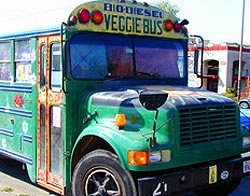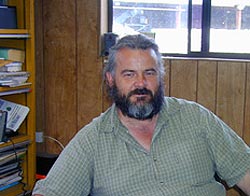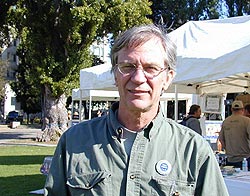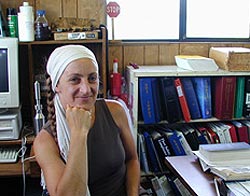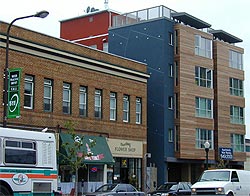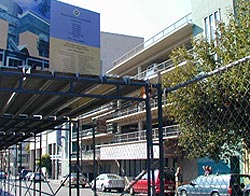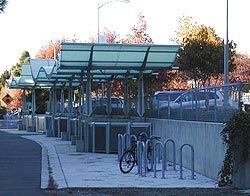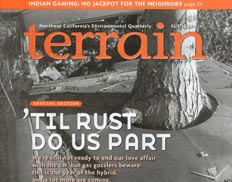|
May 2006 ESEI |
|
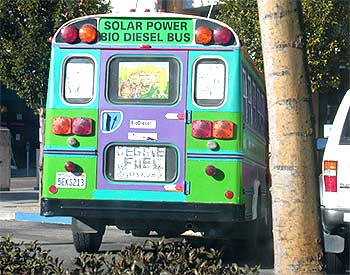
by Turk Kauffman and Lauri Puchall
Berkeley's achievements in the field of environmentalism include a long list of innovations. Through the Ecology Center, the city initiated the first curbside recycling program in the United States in 1973. The Ecology Center continues to produce pamphlets and classes on subjects ranging from the true costs of petroleum, to an introduction to permaculture, to the benefits of solar power and biodiesel. In recent years, grassroots groups such as the Urban Creeks Council, Friends of Strawberry Creek, and Friends of the Five Creeks are attempting to daylight and restore the local network of creeks and bring back wildlife to the watershed. The nonprofit Green Resource Center, founded in 1999 by the Northern California Chapter of Architects, Designers, and Planners for Social Responsibility (ADPSR), the Sustainable Business Alliance, and the city of Berkeley, offers green building research free of charge to residents through its "Ask an Expert" program. Since 2002, Livable Berkeley has been working to facilitate what founder David Early calls "smart growth." EcoCity Builders founder Richard Register--also founder of Urban Ecology (1975)--advocates car-free, people-centered urban space.
In an effort to reduce the number of cars downtown, the 2001 City of Berkeley General Plan has placed a cap on city parking at 2001 levels. According to Peter Hillier, assistant city manager for transportation, there is the added stipulation that all new city-owned parking be added in one location only--the existing 420-space Center Street garage. This garage is seismically unsafe, but no date has been set for its demolition. Transitioning to a Car-free Life Some groups point out that car usage for employees who work downtown, on campus, and in the Southside neighborhood is already the lowest in the East Bay, at only 46 percent. The census determined that just over half (52 percent) of Southside residents owned a car in 1990. The statistic was slightly lower (46 percent) in 2000. Because so many residents, especially students, live without cars in Berkeley, EcoCity Builders, Berkeley Ecological and Safe Transportation Coalition (BEST), and the Preservation Institute authored a car-free ordinance to eliminate parking requirements in designated high-density areas. (Go to: www.preservenet.com/carfreehousing and click on "Draft Car-Free Housing Ordinance" to view the ordinance.)
Digital The transportation department has its own proposal for easing the parking problem. It is in the early stages of planning for digital signage at key gateways to the city directing drivers to vacant spots in downtown city-owned, university-owned, and private parking garages. According to Hillier, the IBI Group is the consultant to the transportation department on the project, the details of which will become public once the city council reviews the proposal later this year. Density
Another multifamily residential project, Library Gardens, is under review at the site of the former 362-space Kittredge Street garage. The project stalled when developer John DeClerq lost the support of the business community by eliminating at least one level of subterranean public parking to save money. Each subterranean spot was estimated to cost $45,000. Downtown visitors and businesses continue to withstand a sizeable (roughly 25 percent) reduction in city public parking since the Kittredge Street garage met the wrecking ball in the summer of 2004. Incentives, Disincentives The Berkeley Daily Planet recently reported that because of widespread community opposition, the university is now reconsidering its plans to add 2,300 parking spaces on campus. And by offering commuter checks, parking discounts for vanpools, free transit, and other incentives, the transportation department encourages commuters to choose public transportation or carpooling instead of driving. Matt Nichols, principal transportation planner for the city of Berkeley, emphasizes the city is "making the most out of existing parking" with "short-term visitor parking" as the highest priority, and "commuter parking discouraged to free up spaces for short-term use, such as shopping." Rather than add university parking--which would be at odds with what the transportation department is trying to accomplish--Hillier would like to see Berkeley expand to employees and residents the existing AC Transit Class Pass program in which students ride UC shuttles, BART, and AC transit free of charge.
Night and Day UC Berkeley parking lots for students, faculty, and staff require permits for daytime use; the lots are accessible to the public during evenings and weekends for a fee. By designating prime-time restricted parking and off-peak general parking, UC serves two distinct populations and stretches the available parking supply further. Businesses like the Bank of America also offer public parking after 5 PM. Provisions for shared parking are written into city codes and regulations. DeClerq had been trying to negotiate a similar type of time-shared parking with the Berkeley YMCA at Library Gardens. Fuel for the Revolution Berkeley is responding to dwindling petroleum supplies and more stringent California emissions requirements with innovation. Several Berkeley organizations and institutions already use alternative fuel for transportation and others are following suit. Lawrence Berkeley National Laboratory vehicles run on biodiesel or ethanol from the laboratory's own pump. AC Transit is now looking into hydrogen. Watch for the light blue hydrogen fuel cell buses cruising around town, courtesy of Arnold Schwarzenegger and ChevronTexaco, although the anticipated three new buses won't stop to pick up passengers until fall 2005. Dave Williamson, recycling operations manager for the Ecology Center curbside recycling program in Berkeley, cautions that "hydrogen (as proposed) is not produced using sustainable processes."
Vision, Planning, Patience Many of the transportation department's stated goals, such as using existing parking more efficiently and encouraging people to take public transportation, are universally well supported. Yet cars are so engrained in our lives that even in Berkeley, groups allegedly on the same side of the fence do not always agree on the best way to reduce automobile usage, but all concede it needs to happen, particularly downtown and along transit corridors. Increasing urban density and limiting sprawl become controversial goals only when reducing reliance on the personal automobile is understood to be a nonnegotiable means toward those ends. Hillier underscores that parking, as a subset of driving, is a regional issue and that change needs to occur beyond Berkeley's boundaries. "A major challenge for Berkeley," he explains, "is to not only identify its position on sustainable transportation, but to pursue its own policies in the context of the Bay Area, where some neighboring communities are expanding in a suburban way ... while promoting more car use in the area. Berkeley has the opportunity to show leadership in this field... ."
There is a strong support among diverse groups for making Berkeley more livable by encouraging vibrant mixed-use districts designed around people, not cars. SaraHope Smith insists that we don't have to renounce comfort and ease to have a sustainable city. She encourages "supporting the human side" of technology by "using technology with wisdom and greater simplification." One of the most inventive suggestions commensurate with a sustainable vision for the city comes from EcoCity Builders. In following ecological planning principles to their logical conclusions, they offer transfer of development rights as a strategy for defining clear-cut boundaries between developed and open space. Those boundaries would apply to the automobile as well. If a project such as the Heart of the City is successful, it may help (de)pave the way for more flexible zoning and sustainable development.

|
||||||||||||||||||||||||
|
ESEI is looking for short fiction, extracts of novels, poetry, lyrics,
polemics, opinions, eyewitness accounts, news, features, information and arts
in any form relating to eco cultural- social- spiritual issues, events and
activites (creative and political). Send to Newsdesk. |

